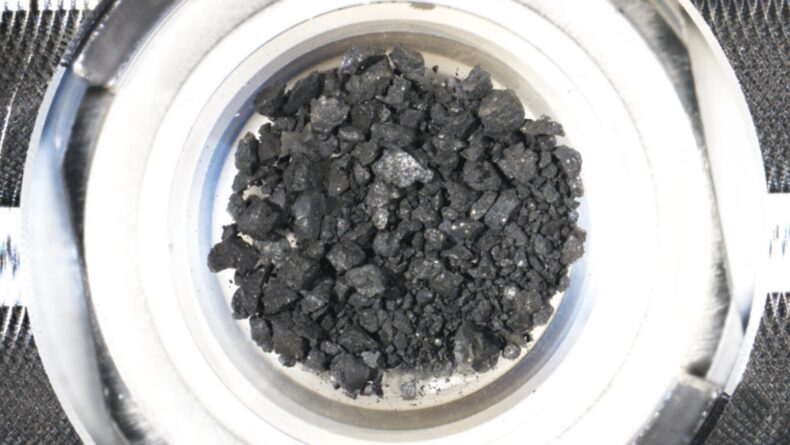Scientists have found evidence before from asteroids and meteorites that crashed on the Earth having evidence of Life. But, they were not sure whether the chemicals indicating the presence of Microbial life in those asteroids and meteorites were from space or contaminated by the earth because of the crash.

The image you see above contains a sample of 31 milligrams of dust and debris from an Asteroid named Ryugu and is the most pristine piece of sample from our Solar System scientists have ever studied. This mission was taken up by JAXA ( Japan Aerospace Exploration Agency ) to study the Asteroid Ryugu some 300 million kilometers away and bring back samples from it to study them. Hayabusa-2 probe was the spacecraft that did this work which was launched in 2014 and bought back the samples in a capsule in the late 2020s.
The findings of the asteroids investigation
The black powder full of dust and particles you see in the image above that looks like charcoal contains an important component of LIFE itself. In a new research study, Researchers have discovered that the sample contains a chemical compound namely Uracil, which is one of the building blocks of RNA in just 10 milligrams of the material that was brought back from the asteroid.

This research stems from the analysis of 5.4 grams of the sample that the Hayabusa-2 probe brought back from the asteroid. This finding adds weight to the theory that Life may have been seeded here on Earth from asteroids and meteorites that crash here that contains Life’s fundamental building blocks.
The sample that returned from the asteroid in the Hayabusa-2 probe was divided among international research teams that gave birth to many insights one of them being that Amino Acids which are an important building block of Life may have formed in space.
In Near-Earth Asteroids the first traces of water were found, this was also found in the samples. The research study that found life traces published in the journal Nature Communications sought another foundation of life besides water i.e RNA nucleobases.
Even though DNA the double-stranded helix contains the genetic information, the single-stranded RNA is an important messenger that converts the information in the DNA for implementation. RNA like DNA comprises Adenine, Guanine, Cytosine, and Uracil. As mentioned at the beginning scientists found all these chemicals in asteroids and meteorites that crash on earth but were unsure whether they were pristine or contaminated from the crash.
An associate professor at Hokkaido University, Yasuhiro Oba who is also the author of the research said, all the meteorites that crash on the earth where microorganisms are present everywhere, analysis of the origin of such biologically important molecules in meteorites is a complex and hard task to achieve. Oba also told the AFP that this discovery provides evidence that even before the origin of life, RNA components were seeded on the Earth. He also added that they expect it plays an important role in the origin of Life and Prebiotic evolution.
RNA’s other components were not found in the sample brought back by the Hayabusa-2 probe but Oba believes that the presence of those components in the sample is at a very low level to be detected by the experiments they used to detect Uracil. He also hopes to analyze the samples collected from space in coming years for example the OSIRIS-REx’s samples collected from asteroid Bennu, which is expected to arrive this year.
Mars Exploration Project which is set to launch from Japan next year and to be returned around 2029, will collect samples from Phobos, one of the moons of Mars. A scientist at the Japan Agency for Marine-Earth science and technology namely Yoshinori Takano an author of the Ryugu research said he was keenly awaiting the Mars Exploration Project. He said for the next ten years he was sure it will be very Hotly watched by Organic Cosmochemists.













